Stephen Morris's Blog, page 16
August 24, 2020
“My Beloved is a sachet of Myrrh”
 Medieval illumination of the royal couple in the Old Testament Song of Songs, also known as the Song of Solomon
Medieval illumination of the royal couple in the Old Testament Song of Songs, also known as the Song of Solomon“My beloved is to me a sachet of myrrh resting between my breasts.” (Song of Solomon 1:13 ) St. Gregory of Nyssa comments on this, saying: “The Lord Himself, having become a balsam of myrrh (in His death) and taken residence in my heart itself, occupies the center of my awareness.” St. Bernard of Clairvaux also understands the bitter myrrh as an emblem not only of Christ in the Passion but as the personal repentance of each believer. “This perfume of repentance,” he preaches, “reaches to the very abodes of the blessed in heaven…. God will not scorn this crushed and broken spirit. This [myrrh] not only inspires us to amend our lives but even makes the angels dance for joy,” because the angels greatly rejoice over one sinner who repents. “Those who have renounced sinful ways are inevitably gripped by bitterness and confusion… like fresh wounds” but the bitterness of the myrrh gives way to the sweet scent of the oil of gladness described in Psalm 45:8 (which also describes the royal bride preparing to wed her groom).
In modern Judaism the Song is read on the Sabbath during the Passover, which marks the beginning of the grain harvest as well as commemorating the Exodus from Egypt. Jewish tradition reads it as an allegory of the relationship between God and Israel, while Christian tradition reads it as an allegory of Christ and his “bride”, the Church.
The Church’s interpretation of the Song as evidence of God’s love for his people, both collectively and individually, began with Origen. Over the centuries the emphases of interpretation shifted: first, reading the Song as a depiction of the love between Christ and Church; in the 11th century, it was read as describing the relationship between Christ and each Christian; in the 12th century the Bride was seen as the Virgin Mary, Each of these new readings absorbed rather than simply replaced earlier interpretations, so that the commentary became ever more complex. Reading the Song of Songs as a theological metaphor reveals the two partners–whether understood as Christ and the Church, Christ and each believer, or God and the Blessed Virgin–are eternally bound in a relationship that the idea of “marriage” can only approximate.
The post “My Beloved is a sachet of Myrrh” appeared first on Stephen Morris, author.
August 17, 2020
“I am Black and Beautiful:” the Queen of the South
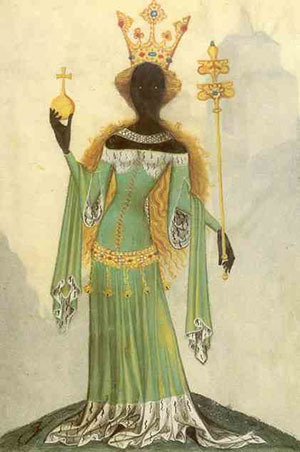 The Queen of Sheba, from a 15th-century manuscript now at Staats – und Universitätsbibliothek Gottingen
The Queen of Sheba, from a 15th-century manuscript now at Staats – und Universitätsbibliothek Gottingen 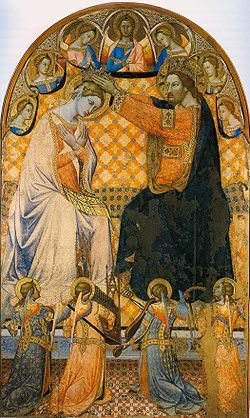 Sanctae Mariae Coronavi by Giacomo di Mino‘s Gothic version. Circa 1340–1350
Sanctae Mariae Coronavi by Giacomo di Mino‘s Gothic version. Circa 1340–1350 The Queen of Sheba, whom Jesus refers to as “the Queen of the South” who “came from the uttermost parts of the earth”, i.e. from the extremities of the then known world, to hear the wisdom of Solomon (Matthew 12:42, Luke 11:31), has long fascinated us. She is a mysterious figure who appears briefly in 1 Kings 10 and 2 Chronicles 9 and then seems to vanish again. Who was she? What do we really know about her? Why should we care?
Sheba, also known as “Saba,” is mentioned in the Psalms. It was a wealthy kingdom that included modern Yemen and Ethiopia and was connected to a vast network of trading routes and business exchanges. When the Queen came to visit King Solomon, it might well have been a trade mission–a sort of G8 meeting!–to make new trade deals and sign new business agreements between the two monarchs. Solomon and the Queen were both known for their wisdom and keen senses; while striking their business deals, they traded riddles. Folklore has suggested many possible riddles that they might have traded, including the famous, “What land has only seen the sun once?” (Answer: the bottom of the Red Sea, which was exposed to sunlight when it parted for Moses and the Hebrews to escape from Egypt.)
Origen, who wrote a voluminous commentary on the Song of Songs, identified the bride of the Song with the “queen of the South” of the Gospels, i.e. the Queen of Sheba, and assumed she was Ethiopian as the bride in the Song says, “I am black and beautiful” (μέλαινα εἰμί καί καλή ). Not only is the bride in the Song identified as the Queen of Sheba, the bride is also understood by Christians to be an allusion to both the Church and the Mother of God. (It is the identification of the Mother of God with the dark and beautiful bride that results in the depictions of the “black Madonna.”) Because of the identification of the bride as Queen, Church, and Mother of God, the Queen of Sheba herself comes to be seen as a type of the Church and the Mother of God: the wonderful gifts of gold and incense that the Queen brings Solomon is seen as a foreshadowing of the adoration of the Magi (Matthew 2) and the Queen of Sheba enthroned represents the coronation of the virgin.
The post “I am Black and Beautiful:” the Queen of the South appeared first on Stephen Morris, author.
August 10, 2020
Moses Atop Mt. Tabor and Mt. Sinai
 The Transfiguration of Christ: Part of an iconostasis from Mt. Sinai in the style of Constantinople (mid-12th century). We see the Prophet Elijah as an older man beside Christ and Moses, holding a copy of the Law given to him on Mt. Sinai, on Christ’s other side. St. Peter kneels below Elijah, with St. John the Divine below Christ and St. James below Moses.
The Transfiguration of Christ: Part of an iconostasis from Mt. Sinai in the style of Constantinople (mid-12th century). We see the Prophet Elijah as an older man beside Christ and Moses, holding a copy of the Law given to him on Mt. Sinai, on Christ’s other side. St. Peter kneels below Elijah, with St. John the Divine below Christ and St. James below Moses.Christ took the apostles Peter, James, and John the Divine to the top of Mt. Tabor to pray. The apostles fell asleep. When they awoke, they saw Christ transfigured–more brilliant than the sun–and Moses was there, with the Prophet Elijah, speaking with Christ about the Passion that Christ would soon experience in Jerusalem. (Moses and Elijah–the primary representatives of the Law and the Prophets of the Old Testament–were also representative of the living and the dead as Elijah was taken alive into heaven by the chariot of fire and Moses died on Mt. Nebo just outside the Promised Land.)
Although seen by the apostles on Mt. Tabor, Moses is more commonly associated with Mt. Sinai. The famous monastery of St. Catherine (a treasure trove of manuscripts and icons) marks the place on Mt. Sinai where Moses is said to have encountered God–his own face shining more brightly than the sun afterwards–and Moses gazes out at the congregation in the monastery church from the Transfiguration mosaic behind the altar-table; the church on Mt. Sinai is dedicated to the Transfiguration, underscoring Moses’ connections with both Sinai and Tabor.
The oldest record of monastic life at Sinai comes from the travel journal written in Latin by a woman named Egeria about 381–384. She visited many places around the Holy Land and Mount Sinai, where, according to the Old Testament, Moses received the Ten Commandments.
The monastery was built by order of Emperor Justinian I (reigned 527–565), enclosing the Chapel of the Burning Bush (also known as “Saint Helen’s Chapel”) ordered to be built by Empress Helena, mother of Constantine the Great, at the site where Moses is supposed to have seen the burning bush. The living bush on the grounds is purportedly the one seen by Moses. The place where Moses is said to have received the Ten Commandments is further up the mountain, behind the monastery.
The library at the monastery preserves the second largest collection of early codices and manuscripts in the world, outnumbered only by the Vatican Library The large icon collection begins with a few dating to the 5th-6th centuries; these icons are unique as the monastery was untouched by Byzantine iconoclasm, and never sacked.
 A view of St Catherine’s Monastery on Mt. Sinai
A view of St Catherine’s Monastery on Mt. Sinai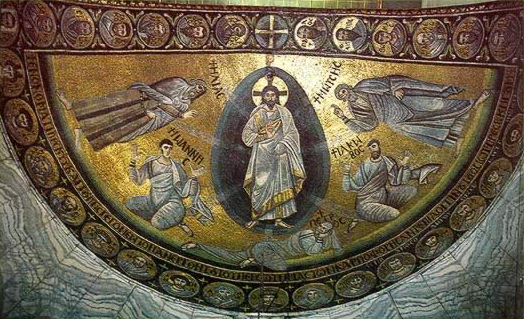 Apse mosaic of the Transfiguration from Saint Catherine’s Monastery, Mt. Sinai, AD 565–6.
Apse mosaic of the Transfiguration from Saint Catherine’s Monastery, Mt. Sinai, AD 565–6.The post Moses Atop Mt. Tabor and Mt. Sinai appeared first on Stephen Morris, author.
August 3, 2020
New Feature–View Recordings of Talks
 Photo by Rev. Tony Lewis
Photo by Rev. Tony LewisThere is a new feature here! Did you miss an event or a talk? Now you can view Zoom recordings of Bible Studies or listen to podcasts and other interviews I have done. There is a new tab on the website header; Look for “Bible Study or Other Talks.” Click on it. You will see a long list of interviews I have done on various podcasts as well as Bible Study sessions on Zoom. Click on whichever you want to listen to or view–some of the Zoom sessions require a password, which is listed there for you to copy-and-paste.
Check back on the “Bible Study or Other Talks” page often. It will be updated at least once a week, if not more frequently. There are more recordings in April that I am in the process of adding as well as more recent events. I expect this to continue even after the pandemic restrictions ease: Zoom recordings are just a standard feature of life now.
If I find other talks or presentations that I think you might be interested, I will add a few of those links as well. Keep checking back and see what’s new on the new “Bible Study or Other Talks” page!
The post New Feature–View Recordings of Talks appeared first on Stephen Morris, author.
July 27, 2020
Sant’Apollinare in Ravenna & the Magi
 Magi leading the Empress Theodora and the wise virgin-martyrs in procession to the Mother of God and Christ in the church of San Apollinaire in Ravenna.
Magi leading the Empress Theodora and the wise virgin-martyrs in procession to the Mother of God and Christ in the church of San Apollinaire in Ravenna.St. Apollinaire was a Syrian, elected to be the first bishop of Ravenna (which was later the Byzantine capital of Italy). As the first bishop of Ravenna, he faced nearly constant persecution. He and his flock were exiled from Ravenna during the persecutions of Emperor Vespasian (or Nero, depending on the source). On his way out of the city he was identified, arrested as being the bishop, tortured and martyred by being run through with a sword.
The church of San Apollinaire in Ravenna is a masterpiece, a jewel of Byzantine iconography and mosaics. It was erected by the Ostrogothic king Theodoric the Great during the first quarter of the 6th century. It was re-consecrated in AD 561, under the rule of the Byzantine emperor Justinian I, Justinian and his wife, the empress Theodora, appear in the mosaics of the church, each leading a segment of the offertory procession towards the altar during the celebration of the Eucharist.
The mosaics also depict a procession of the wise virgin-martyrs, led by the Three Magi, moving towards the group of the Madonna and Child surrounded by four angels. (The Magi in this mosaic are named Balthasar, Melchior and Gaspar; this is thought to be the earliest example of these three names being assigned to the Magi in Christian art.) The Magi are wearing trousers and Phrygian caps as a sign of their foreign origin. The gifts which the Magi and the wise virgins bring are reflections of the gifts which the congregation are bringing to present: bread, wine, water for the celebration of the Eucharist and food or clothes to be distributed among the poor and needy during the week.
The celebration of the Eucharist was often seen as a procession or pilgrimage in which the parish journeyed from earth to the Kingdom of God and then returned to earth to minister during the week what they had received on Sunday. During the celebration, the parish stepped outside time to stand alongside the Magi, the priest-king Melchizedek, Abraham and Isaac—all of whom also appear in the mosaics of this church—with the saints and martyrs of all times and places to worship God in eternity (as described in the Epistle to the Hebrews and the Book of Revelation, which are the first liturgical commentaries). The offertory procession is a visual shorthand to refer to the entire celebration.
The Magi were consistently venerated as the first non-Jews to come and worship Christ so they were considered the patron saints of all Christians of Gentile backgrounds. A shrine of the Three Kings at Cologne Cathedral, according to tradition, contains the bones of the Magi. Reputedly they were first discovered by Saint Helena on her famous pilgrimage to Palestine and the Holy Lands. The remains were first kept in the church of Hagia Sophia in Constantinople; they were later moved to Milan before being sent to their current resting place by the Holy Roman Emperor Frederick I in 1164.
What prompts these thoughts about Ravenna, St. Apollinaire, and the Magi? The martyrdom of the saint and the translation of the relics of the Magi to Cologne are both commemorated on the same day (July 23).
Read more about the Magi in previous posts here and here and here.
The post Sant’Apollinare in Ravenna & the Magi appeared first on Stephen Morris, author.
July 20, 2020
Archangel Uriel
 Mosaic of St. Uriel by James Powell and Sons, at St John’s Church, Warminster.
Mosaic of St. Uriel by James Powell and Sons, at St John’s Church, Warminster.  Saint Uriel (meaning ‘God is my light’ or ‘light of God’), one of four stained glass windows in the cloisters of Chester Cathedral depicting the Archangels mentioned in the Christian Bible. Uriel is often depicted holding flame or the sun.
Saint Uriel (meaning ‘God is my light’ or ‘light of God’), one of four stained glass windows in the cloisters of Chester Cathedral depicting the Archangels mentioned in the Christian Bible. Uriel is often depicted holding flame or the sun. Archangel Uriel appears in the Second Book of Esdras found in the Biblical apocrypha in which the prophet Ezra asks God a series of questions and Uriel is sent by God to instruct him. This is one of my favorite episodes involving angels: Ezra asks Uriel to explain the visions to him and Uriel replies: “I will answer your question if you can answer mine: How much does fire weigh? How much wind can fit in a bag? Where does the day go when it is over?” Ezra cannot answer these and Uriel tells him, “If you cannot answer these questions about things you have direct experience of, how can you expect to understand the secrets of God, which you have no direct experience of?”
In Christian folktales, Uriel plays a role in the rescue of Jesus‘ cousin John the Baptist from the Massacre of the Innocents ordered by King Herod. St. Uriel carries St. John the Baptist and his mother Saint Elizabeth to join the Holy Family after their Flight into Egypt. This family reunion is depicted in Leonardo da Vinci‘s Virgin of the Rocks.
In other Christian folktales, St. Uriel stands at the Gate of Eden with a fiery sword and in the Life of Adam and Eve, Uriel is said to be one of the cherubim described in the third chapter of Genesis guarding the Tree of Life. He is also identified as one of the angels who helped bury Adam and Abel on the edge of Eden.
In British Christianity, St. Uriel is sometimes considered the Patron Saint of the Sacrament of Confirmation. The motto of Oxford University (“Dominus illuminatio mea“) is thought by some to be a variation of St. Uriel’s name in Latin.
The post Archangel Uriel appeared first on Stephen Morris, author.
July 13, 2020
SS. Raphael, Gabriel, and the Trumpet
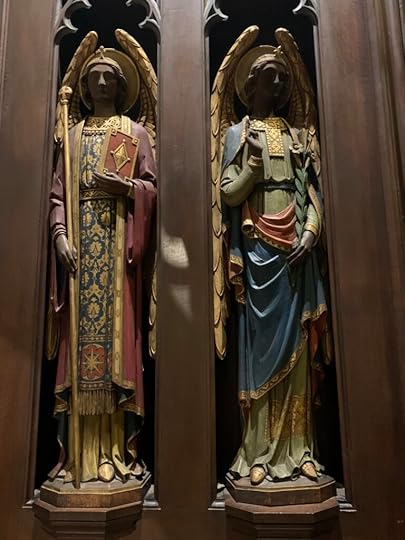
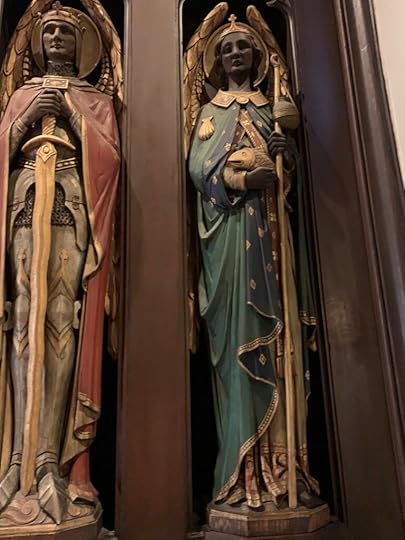 Statues of the four archangels at the Church of the Transfiguration (“Little Church Around the Corner”) in New York City: Uriel holds the book, Gabriel the lily, Michael the sword, and Raphael the fish. Read the history of the Little Church here.
Statues of the four archangels at the Church of the Transfiguration (“Little Church Around the Corner”) in New York City: Uriel holds the book, Gabriel the lily, Michael the sword, and Raphael the fish. Read the history of the Little Church here.The Archangel Raphael is said to be the angel always ready to blow the trumpet to announce the General Resurrection and the End of Time, according to Islam. Christians, on the other hand, expect the Archangel Gabriel to be the one who will blow the trumpet on the Last Day to announce the General Resurrection and Judgement.
For the Lord himself will come down from heaven, with a loud command, with the voice of the archangel and with the trumpet call of God, and the dead in Christ will rise first.
(1 Thess. 4:16)
A statue of Gabriel, often depicted with the lily which is associated with the Mother of God (because he brought the Good News of the Annunciation to the Blessed Virgin), is frequently found atop the roof at the east end of churches already blowing the trumpet. It is always Gabriel’s job to announce; he is the “announcer” of God.
We are told in the Old Testament to blow a trumpet to celebrate the New Year (Leviticus 23:24) or to announce a fast (Joel 2:15). Trumpets announce the coming of God as king and call the people to get ready to greet him. In the New Testament, trumpets announce the arrival of God’s judgement and call the people to turn their lives around (“repent”) in order to face the coming judgement. That is why Gabriel blows the trumpet atop a church: to announce the End that comes during the celebration of the Eucharist on the altar below the statue’s feet.
The most famous trumpets in the Bible are the seven trumpets blown in the Book of Revelation (Rev. 8-11). Angels blow the first six trumpets to call sinners on Earth to repentance. Each trumpet blast brings a plague, each one more disastrous than the one before it. The trumpet is used to build anticipation and tells the reader that an alert, announcement, or warning is about to take place. The seventh trumpet does not bring a plague with it. Instead, an angel blows the seventh trumpet to announce the glory of God and the coming of his kingdom.
How did Raphael get associated with the trumpet in Islam? Islamic folklore says that Raphael was the first of the archangels to be created and that he visited Mohammed even before the archangel Gabriel came to reveal the Qur’an. The Islamic folktales also say that Raphael is a master of music, who sings praises to God in a thousand different languages. It is probably this association with music that results in Raphael being given the honor of blowing the trumpet.
We never read explicitly in the New Testament that Gabriel is the archangel that will blow the trumpet on Judgement Day. I think we have come to expect him to do this precisely because he is God’s “announcer,” who announced the meaning of Daniel’s visions to the prophet (Daniel 8-9) and the birth of John the Baptist to his father Zachary as well as the birth of Christ to the Mother of God. So we expect him to announce the End of Time and the General Resurrection as well.
But the association of Gabriel with the trumpet can only be dated with certainty to the 1300s: the earliest known identification of Gabriel as the trumpeter comes in John Wycliffe’s 1382 tract, De Ecclesiæ Dominio. In the year 1455, there is an illustration in an Armenian manuscript showing Gabriel sounding his trumpet as the dead climb out of their graves. Two centuries later, Gabriel is identified as the trumpeter, in John Milton‘s Paradise Lost (1667).
The post SS. Raphael, Gabriel, and the Trumpet appeared first on Stephen Morris, author.
July 6, 2020
St. Raphael, Looking Out For Mankind–and New York!
 A modern painting of the Archangel Raphael in 17th-18th century Peruvian style by Elizabeth Alvarez. He is holding the fish that was so important in healing the blind and the possessed.
A modern painting of the Archangel Raphael in 17th-18th century Peruvian style by Elizabeth Alvarez. He is holding the fish that was so important in healing the blind and the possessed.Archangel Raphael tells us in the Book of Tobit that he is one of the seven archangels that stand before the throne of God, offering the prayers of the saints like incense. We know the names of three other archangels: Michael, Gabriel, and Uriel. Michael is known as a warrior and Gabriel is a messenger while Uriel is a keeper of secrets but Raphael is known as a healer.
In Tobit, St. Raphael tells Tobias how to use the heart, liver, and gall of a large fish to save Sarah and heal his father’s eyes. Because of this, Raphael is often considered the patron of the blind and of pharmacists who mix or oversee the use of medicinal herbs and drugs for healing ailments. Because he also bound the demon Asmodeus in chains when Asmodeus fled to Egypt, the archangel is also the guardian of those possessed or under attack by the demons. Asmodeus attacked Sarah at night, so Raphael is invoked against nightmares.
In the Old Testament, the land of Egypt is both a symbol of fertility or safety and the “land of the shadow of Death,” the region most associated with all that is opposed to God. Egypt was the source of food that saved Joseph and his brothers and the people of Israel who came to escape the famine in the Promised Land. Egypt is the fertile bread basket of the Ancient World, including Greece and the Roman Empire. The importance of Egypt as food source continued into the Byzantine period. The known world relied on Egypt to survive for centuries. The prophets refer to Egypt as a garden similar to Eden (esp. Jeremiah and Isaiah), providing all that humans need to live. Yet Origen says that “Egypt” is the world steeped in Death because Pharaoh opposed God, inflicting suffering and death on the Chosen People; Pharaoh brought down the Ten Plagues, killing many of his own people as the water was undrinkable or the cattle sickened and died even before the firstborn were slain. Most of his soldiers drowned at the Red Sea. The gods worshipped in Egypt were thought to be devils in disguise by the Christians as well. The wilderness of the Egyptian desert was the home of devils and demons so mons and nuns went out into the wilderness to pray and fight against the devil on his own turf.
Asmodeus fled to Egypt because that was the natural home on earth of all demons. Raphael bound him in chains and imprisoned Asmodeus in Egypt because the desert of Egypt is the icon of Hell.
In Greek, the words “health” and “salvation” are slightly different versions of the same word. Miracles of healing are paradigms of salvation. Raphael brought health and salvation to Tobit, Tobias, and Sarah–the family that stands in for the human race. Because Raphael saved them, he guards and protects us all.
St. Raphael keeps an eye on New York as well. He stands atop the Bethesda Fountain in Central Park (designed by Emma Stebbins, who was the first woman to receive a public commission for a major work of art in New York City and completed in 1873) because the fountain refers to Healing the paralytic at Bethesda, a story from the Gospel of John (chapter 5) about an angel blessing the Pool of Bethesda, giving it healing powers. Folklore has always insisted that the angel who troubled the water at Bethesda was St. Raphael.
The post St. Raphael, Looking Out For Mankind–and New York! appeared first on Stephen Morris, author.
June 29, 2020
St. Raphael & the Fish-incense
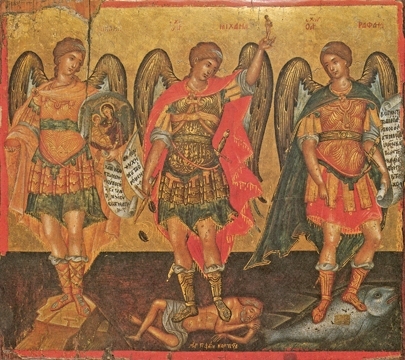 Archangels Gabriel, Michael, and Raphael, identified by their names (above) and images of what they are each known best for: greeting the Mother of God (Gabriel), defeating Satan (Michael), and the fish that saved Tobias and his father (Raphael).
Archangels Gabriel, Michael, and Raphael, identified by their names (above) and images of what they are each known best for: greeting the Mother of God (Gabriel), defeating Satan (Michael), and the fish that saved Tobias and his father (Raphael).In the Old Testament, Tobit falls asleep in a garden and goes blind because the birds drop excrement on his eyes. Meanwhile, in faraway Media, a young woman named Sarah has prayed for death in despair. The demon Asmodeus (“the worst of demons”), abducts and kills every man Sarah marries on their wedding night before the marriage can be consummated. God sends the angel Raphael, disguised as a human, to heal Tobit and free Sarah from the demon.
Tobit sends his son Tobias to collect money that the elder has deposited in distant Media. Raphael presents himself as Tobit’s kinsman, Azariah, and offers to aid and protect Tobias. Under Raphael’s guidance, Tobias journeys to Media with his dog.
Along the way, while washing his feet in the river, a fish tries to swallow Tobias’ foot. By the angel’s order, he captures it and removes its heart, liver and gall bladder.
Upon arriving in Media, Raphael tells Tobias of the beautiful Sarah. The angel instructs the young man to burn the fish’s liver and heart to drive away the demon when he attacks on the wedding night. Tobias and Sarah marry, and the fumes of the burning organs drive the demon to Egypt, where Raphael follows and binds him. Since the wedding feast prevents him from leaving, Tobias sends Raphael to recover his father’s money.
After the feast, Tobias and Sarah return to Nineveh. There, Raphael tells the youth to use the fish’s gall to cure his father’s blindness. Raphael then reveals his identity and returns to heaven, and Tobit sings a hymn of praise.
We are accustomed to very short parables in the Gospels. Most are only a few sentences long; the longest–the Good Samaritan, the Prodigal Son–are a few paragraphs. The Book of Tobit is an extended parable that makes the point that God cares for his people and protects them in many ways. The fish is a good example.
Centuries before it was common to use a cross or crucifix, Christians often used a fish as a symbol of Christ and to indicate a Christian gathering place; the word “fish” in Greek is ichthys which is made of the initial letters of the words “Jesus Christ, Son of God, Savior.” The ichthys symbol is also a reference to the Holy Eucharist, which was associated with the miracle of the multiplication of the loaves and fishes. Christians interpreted the fish in this story of Tobit and Tobias as an allusion to Christ who saves the world from Death by his own death and resurrection.
Tobias takes the organs of the fish that are most full of blood and burns them as incense to drive away the demon. This illustrates the use of incense as an important tool in exorcisms because demons cannot stand the fragrance of incense. Blood is an allusion to both life and death; the bloody organs–liver and heart–are those associated with emotional and spiritual life, as well as physical life and death in the Ancient World. The power of Life–the power of God–made manifest in Christ’s death and resurrection drives the demon Asmodeus away.
The fish’s gall that heals Tobit’s eyes is also interpreted as an allusion to Christ, the light of the world, who heals the blind man in the Gospel of John (chapter 9). The blood of the fish (i.e. the blood of Christ) brings health (a variation of the Greek word “salvation”) to Tobit, Tobias, and Sarah–and to the world.
The post St. Raphael & the Fish-incense appeared first on Stephen Morris, author.
June 22, 2020
Gideon, the Dewy Fleece, & St. Mary Major
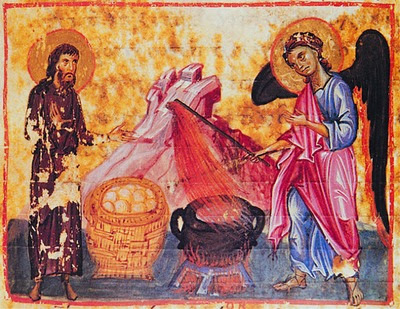 This Byzantine image is another depiction of Gideon and the miracle of the angel meant to reassure Gideon that he was chosen to save Israel from their enemies. There are many more icons of this event here.
This Byzantine image is another depiction of Gideon and the miracle of the angel meant to reassure Gideon that he was chosen to save Israel from their enemies. There are many more icons of this event here. This contemporary Greek image depicts Gideon and the commander of the heavenly armies on the left; on the right is the Mother of God enthroned with Christ. Read more here.
This contemporary Greek image depicts Gideon and the commander of the heavenly armies on the left; on the right is the Mother of God enthroned with Christ. Read more here.I recently wrote about St. Mary Major and the miracle of the snow in Rome. I realized this morning how similar the story about St. Mary Major is to the story of Gideon and the miracle of the fleece in the Old Testament.
In the book of Judges (chapter 6), we read that Gideon was told by an angel that he would save the people of Israel from their enemies as they were settling the Promised Land after wandering in the desert for 40 years after the Exodus. But Gideon wants reassurance that God would fulfil this promise that he would lead the people to victory. He tells the angel,
“If now I have found favor in your eyes, then show me a sign that it is you who speak with me. Please do not depart from here until I come to you and bring out my present and set it before you.” And the angel said, “I will stay till you return.”
So Gideon went into his house and prepared a young goat and unleavened cakes from an ephah of flour. The meat he put in a basket, and the broth he put in a pot, and brought them to him under the terebinth and presented them. And the angel of God said to him, “Take the meat and the unleavened cakes, and put them on this rock, and pour the broth over them.” And he did so. Then the angel of the Lord reached out the tip of the staff that was in his hand and touched the meat and the unleavened cakes. And fire sprang up from the rock and consumed the meat and the unleavened cakes. And the angel of the Lord vanished from his sight. Then Gideon perceived that he was the angel of the Lord. And Gideon said, “Alas, O Lord God! For now I have seen the angel of the Lord face to face.” But the Lord said to him, “Peace be to you. Do not fear; you shall not die.”
After Gideon wins a series of battles, the enemies of Israel gather large reinforcements and Gideon calls for more Israelites to join him. While he is hoping the Israelites will respond to his call and come to join him, we are told that
… Gideon said to God, “If you will save Israel by my hand, as you have said, behold, I am laying a fleece of wool on the threshing floor. If there is dew on the fleece alone, and it is dry on all the ground, then I shall know that you will save Israel by my hand, as you have said.” And it was so. When he rose early next morning and squeezed the fleece, he wrung enough dew from the fleece to fill a bowl with water. Then Gideon said to God, “Let not your anger burn against me; let me speak just once more. Please let me test just once more with the fleece. Please let it be dry on the fleece only, and on all the ground let there be dew.” And God did so that night; and it was dry on the fleece only, and on all the ground there was dew.
Christian preachers always associated both the miracle of the sacrifice consumed by fire and the miracle of the fleece with the Incarnation of the Word of God in the womb of the Virgin Mary. St. Ambrose of Milan preached, “as soon as the Angel touched them with the end of the staff which he bore, fire burst forth out of the rock, and so the sacrifice which he was offering was consumed. By which it seems clear that that rock was a figure of the Body of Christ, for it is written: “They drank of that rock that followed them, and that rock was Christ.” (1 Cor. 10:4)
Other early Christian writers, such as St. Proclus of Constantinople describe the Blessed Virgin as the “loom” of the incarnation and linked the miracle of the fleece with Mary: “The holy Mary has called us together, that undefiled treasure of virginity… the most pure fleece with heavenly dew, from which the Shepherd clothed the sheep… She is the awe-inspiring loom of the incarnation.”
The dew on the fleece that announces God’s choice of Gideon is remarkably similar to the snowfall that announces God’s choice of the building site for the church of St. Mary Major in Rome. Both miracles announce to the world what God has previously revealed to only a few people and both miracles are associated with the Mother of God whose consent made the incarnation possible.
The post Gideon, the Dewy Fleece, & St. Mary Major appeared first on Stephen Morris, author.



